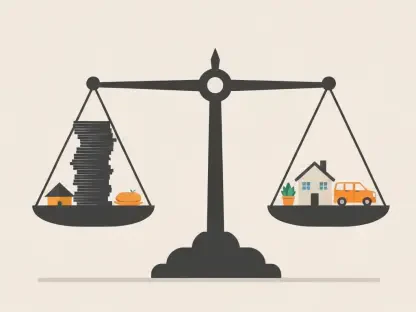The banking sector has long been associated with significant environmental impacts, from the energy consumption of physical branches to the paper waste generated by traditional banking practices. However, the rise of digital banks presents a promising shift towards more sustainable financial practices. By leveraging technology and innovative operational models, digital banks are uniquely positioned to drive environmental change within the industry.
The Environmental Impact of Traditional Banking
Traditional banks have long been entrenched in practices that contribute extensively to environmental degradation. Their operational models demand vast resources, from the construction of brick-and-mortar branches to the pervasive use of paper for transactions, documents, and communications. The environmental toll is further exacerbated by the substantial energy required to maintain these branches, entailing lighting, heating, cooling, and the daily commute of employees and customers.
Fossil Fuel Financing and Its Consequences
Among the most pressing environmental issues associated with traditional banks is their significant role in financing fossil fuel industries. The “Banking on Climate Chaos” report reveals that since the Paris Climate Accords in December 2015, the 60 largest private banks globally have financed fossil fuel activities to the staggering sum of $6.9 trillion. This colossal figure not only highlights the magnitude of traditional banks’ investment in environmentally damaging industries but also underscores their failure to align with global climate objectives.
The implications of such financing are profound. Fossil fuel industries are among the largest contributors to greenhouse gas emissions, driving climate change and environmental destruction. By continuing to channel substantial funds into these industries, conventional banks perpetuate a cycle of environmental harm, contrary to the urgent need for a transition towards greener energy sources. This reality demands a reevaluation of banking practices and supports calls for innovations in financial models that prioritize sustainability.
Physical Branches and Resource Consumption
The traditional banking model is heavily reliant on physical branches, each of which demands considerable resources for construction and maintenance. The environmental footprint of these buildings is significant, encompassing the extraction of building materials, energy consumption for operations, and water usage for various functions. Physical branches also necessitate ongoing maintenance, which further strains environmental resources.
Additionally, the operation of these branches involves high energy consumption, which includes lighting, heating, cooling, and powering various electronic systems. This energy use substantially contributes to the carbon footprint of the banking sector. To compound the issue, the daily commute of employees and customers to these branches adds to the transport sector’s emissions, mainly due to vehicular pollutants. These factors collectively highlight the acute environmental burden posed by the traditional banking infrastructure.
The Digital Banking Advantage
As the world becomes increasingly digital, the banking sector stands on the cusp of a transformative shift. Digital banks, by eliminating the need for numerous physical branches, present a more sustainable alternative. Their operational models leverage advanced technology to optimize efficiency, reduce resource consumption, and minimize environmental impacts. Digital banks operate primarily online, enabling paperless transactions and virtual interactions that collectively contribute to a lower carbon footprint.
Online Operations and Reduced Carbon Footprint
Digital banks predominantly operate online, with minimal or no physical branches. This operational model significantly reduces the carbon footprint associated with commuting to bank branches, as both employees and customers rely entirely on remote interactions. The absence of physical branches means there is no need for the energy-intensive processes involved in lighting, heating, cooling, and maintaining these buildings.
The environmental benefits extend beyond energy savings. The elimination of physical branches conserves natural resources like building materials and water, which are otherwise consumed in constructing and operating brick-and-mortar establishments. Digital banking platforms also facilitate financial transactions and banking services without the geographic limitations posed by physical branches, making access easier and more equitable while contributing to overall sustainability.
Paperless Transactions and Environmental Benefits
One of the most significant environmental advantages of digital banking is the transition to paperless transactions. Traditional banks generate substantial paper waste through the issuance of physical statements, receipts, and various banking documents. In contrast, digital banks operate in a paperless environment, issuing electronic statements and digital receipts. This shift not only reduces the dependency on trees for paper production but also eliminates the environmental costs associated with the paper manufacturing process, such as the use of ink, chemicals, and energy.
The reduction in paper waste translates to direct environmental benefits, including lower deforestation rates and a decrease in the pollution caused by the paper industry. The digital documentation also facilitates improved efficiency and speed in banking operations, enhancing customer convenience while promoting sustainability. By minimizing the environmental footprint associated with paper transactions, digital banks contribute to a greener banking sector.
Consumer and Regulatory Pressure for Sustainability
The growing awareness about climate change and its severe impacts has significantly influenced public expectations and regulatory frameworks. Consumers, regulators, and shareholders increasingly demand transparency and accountability from banking institutions regarding their environmental practices. This cultural shift is driving banks to adopt more sustainable practices and integrate formal ESG (environmental, social, and governance) policies into their operations.
Growing Demand for Transparency and Accountability
As awareness about climate change and environmental preservation intensifies, there is a heightened demand for transparency and accountability in banking activities. Consumers and stakeholders insist that banks disclose their environmental impacts and adopt practices that mitigate harm to the planet. This pressure is compelling traditional banks to reexamine their operational models and align their strategies with sustainable practices.
The shift towards formal ESG policies within the banking sector is a direct response to this growing demand. These policies encompass a range of sustainable practices, from reducing carbon footprints to investing in green initiatives. Banks are now more inclined to incorporate sustainability into their core strategies, not just to comply with regulatory requirements but also to meet consumer expectations and maintain a competitive edge in an increasingly eco-conscious market.
The Role of Media and Public Awareness
Media plays a crucial role in shaping public perception and driving the discourse around environmental sustainability. Increased media focus on environmental protection has further catalyzed the trend towards sustainability in the banking sector. Companies are now more inclined to seek out financial institutions that prioritize green initiatives, recognizing the reputational benefits and consumer approval that accompany sustainable practices.
This burgeoning public awareness is a powerful motivator for banks to enhance their sustainability efforts. Financial institutions understand that aligning with environmentally responsible practices not only fulfills regulatory requirements but also fosters goodwill and bolsters their brand image. Consequently, the banking landscape is evolving, with sustainability increasingly becoming a cornerstone of operational strategies and business models.
Case Studies: Digital Banks Leading the Way
Several digital banks are at the forefront of embedding sustainability into their operational models, setting examples for the broader financial industry. By leveraging technology and innovative strategies, these institutions are demonstrating how the banking sector can reduce its environmental impact and lead the way towards a greener future. Case studies of digital banks like Monzo and Revolut illustrate these efforts and highlight their success in integrating sustainability into core business practices.
Monzo’s Commitment to Net-Zero Emissions
British online bank Monzo provides an exemplary case study on how digital banks can navigate the challenge of reducing carbon emissions. Monzo’s emissions are predominantly categorized as Scope 3 (95.97 percent), with only minimal contributions from Scope 1 and Scope 2. This categorization reflects the indirect emissions resulting from the bank’s investment and lending activities, supply chain operations, and customer-related operations.
Monzo has committed to achieving net-zero emissions by 2030, a goal that underscores its dedication to sustainability. To reach this target, the bank is actively working to reduce emissions across its supply chain. This includes incorporating suppliers’ climate goals into procurement processes and fostering partnerships that prioritize environmental standards. Monzo’s comprehensive approach to managing emissions highlights the potential for digital banks to lead the charge in environmental sustainability.
Revolut’s Real-Time Carbon Footprint Measurement
Revolut, another leading digital bank, operates entirely online without any physical branches, thereby limiting its direct emissions. The bank’s approach to sustainability is characterized by its proactive measures to monitor and manage its environmental impact. By collaborating with enterprise sustainability platforms such as Watershed, Revolut measures its carbon footprint in real-time, allowing for accurate tracking and reporting of emissions.
Developing strategies to reduce its environmental impact is central to Revolut’s sustainability initiatives. The bank leverages technology to optimize operational efficiency, reduce waste, and minimize its carbon footprint. Revolut’s commitment to transparency and real-time measurement demonstrates how digital banks can integrate sustainability into their core operations, setting a standard for others in the industry.
Challenges and Opportunities for Digital Banks
Despite their inherent advantages, digital banks face several challenges in their quest for sustainability. The substantial energy consumption required by data centers and servers, as well as the generation of electronic waste, pose significant obstacles. However, the digital banking model also presents unique opportunities to leverage technology and drive innovation in environmental sustainability.
Addressing Electronic Waste and Energy Consumption
While digital banks offer a more sustainable alternative to traditional banking, they are not without their environmental challenges. The significant energy consumption required by data centers and servers is a major concern, as these facilities demand vast amounts of electricity to operate efficiently. This energy use contributes to the overall carbon footprint of digital banks, underscoring the need for strategies to enhance energy efficiency and adopt renewable energy sources.
Electronic waste is another pressing issue in digital banking. The rapid pace of technological advancement means that electronic devices and systems quickly become obsolete, generating substantial amounts of e-waste. Managing this waste responsibly requires robust recycling programs and sustainable disposal practices. Digital banks must address these challenges to ensure that the environmental benefits of their operational models are not overshadowed by these drawbacks.
Leveraging AI and Digital Technologies
The World Economic Forum (WEF) posits that technologies such as artificial intelligence (AI) can play a pivotal role in predicting and mitigating environmental risks. AI can optimize energy consumption in real-time, enabling digital banks to reduce their operational carbon footprint. Automation processes can also streamline operations, reduce waste, and enhance the sustainability of production systems.
By leveraging AI and other digital technologies, both digital and traditional banks can significantly improve their environmental performance. These technologies offer the potential to enhance efficiency, minimize resource consumption, and drive innovation in sustainable banking practices. Digital banks, with their tech-centric models, are particularly well-positioned to lead in this area, setting benchmarks for sustainability and driving the broader banking sector towards greener practices.
The Path Forward for Sustainable Finance
The pathway to a more sustainable banking sector involves comprehensive measures to address carbon emissions, foster collaboration and innovation, and leverage digital technologies. Digital banks, with their inherent sustainability advantages, are at the forefront of this transition. However, achieving genuine sustainability requires a concerted effort across the entire financial industry.
Comprehensive Emission Measurement and Management
For a meaningful shift towards sustainable finance, digital banks must comprehensively address carbon emissions resulting from their investment targets and customer-related activities. The Greenhouse Gas (GHG) Protocol provides standardized frameworks for measuring and managing GHG emissions in three categories: Scope 1 (direct emissions from owned sources), Scope 2 (indirect emissions from purchased energy), and Scope 3 (indirect emissions from the value chain).
Since Scope 1 and Scope 2 emissions are usually minimal for digital banks, the primary concern lies with Scope 3 emissions. These encompass the indirect emissions tied to the banks’ investment and lending activities, supply chain operations, and customer interactions. By adopting the GHG Protocol frameworks, digital banks can accurately measure, manage, and reduce their overall carbon footprint, leading the transition towards more sustainable financial practices.
Collaboration and Innovation in the Banking Sector
The banking industry has traditionally been linked with considerable environmental impacts, ranging from the massive energy consumption required to operate physical branches to the significant paper waste generated by conventional banking activities. Nevertheless, the advent of digital banks heralds a promising shift towards more sustainable financial practices. By harnessing advanced technology and innovative business models, digital banks are fundamentally transforming the financial sector.
Digital banks significantly reduce the need for physical branches, which in turn cuts down on energy use and greenhouse gas emissions. Additionally, they minimize paper waste by offering digital statements, online banking, and remote deposit capabilities. This not only lowers resource consumption but also appeals to environmentally conscious consumers seeking greener alternatives.
Moreover, digital banks can streamline operations with automation and enhanced efficiency, further diminishing their environmental footprint. With cloud computing and blockchain technology, financial transactions become faster and require less physical infrastructure, contributing to the overall sustainability of the sector.
In conclusion, the rise of digital banks offers an exciting opportunity to reform the banking industry by adopting more sustainable practices. By leveraging these innovations, digital banks are not only improving convenience for customers but also playing a critical role in protecting the environment. This shift marks a crucial step towards a more sustainable and responsible financial future.









